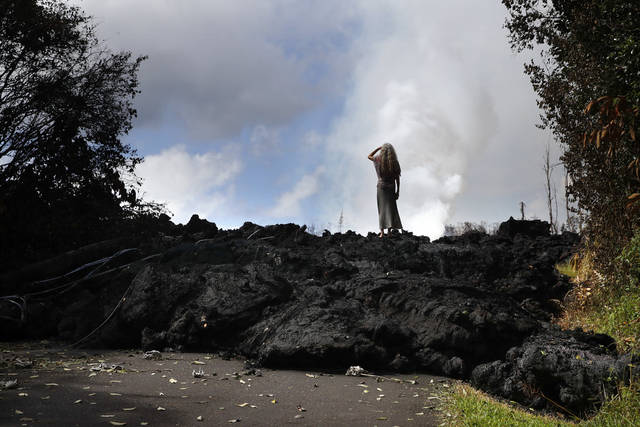President Trump’s declaration paves way for funding as officials plan for more possible eruptions and evacuations


ASSOCIATED PRESS
Hannique Ruder, a 65-year-old Leilani Estates resident, stood on a mound of hardened lava Friday near Pahoa.


HILO >> The Hawaii National Guard says it is ready to evacuate up to 2,000 people from Lower Puna in case a volcanic eruption threatens those residents or cuts them off from the rest of Hawaii island.
Lt. Col. Shawn Tsuha, commander of Task Force Hawaii — the military operation to respond to the volcanic outbreak on Hawaii island — said Friday the soldiers and airmen can move more than 200 people at a time in a convoy and that if roads are blocked they can move people by air.
He said the operation has four Black Hawk helicopters available to hoist people to safety, and the active-duty Army at Pohakuloa Training Area has offered to help with four Chinook helicopters, which can carry about 30 people at a time.
Tsuha said he was told by the county that there are about 2,000 people in Lower Puna who could be cut off by new lava outbreaks.
Meanwhile, President Donald Trump on Friday declared the volcanic eruption and related earthquakes a “major disaster” in Hawaii, opening up federal assistance for repairs and hazard mitigation, the White House said in a statement.
RELATED
Don't miss out on what's happening!
Stay in touch with breaking news, as it happens, conveniently in your email inbox. It's FREE!
>> Wary residents in lava zone hope for the best, prepare for the worst
>> Kilauea’s emissions spread to Oahu, if only for a day
>> Kapoho to Kalapana on alert
>> Photos: Tourists stay despite eruption threats from Kilauea
—
* More coverage of the Kilauea eruption
* Video Playlist: Kilauea Volcano
Trump’s declaration was in response to Gov. David Ige requesting a presidential disaster declaration for Hawaii island a day earlier.
Ige’s office said the declaration additionally covers costs for emergency personnel for security and roadblocks, geologists and the military.
Also, Friday marked the second consecutive day that no lava came from any of the 15 fissures in the East Rift Zone, but officials warned that additional lava outbreaks were likely.
Talmadge Magno, Civil Defense administrator for the Big Island, said the county has put out messages warning residents of the potential danger by radio, text and social media and have started going door to door.
He said in Volcano, closer to Kilauea’s summit where there is the possibility for an explosive eruption at Halemaumau Crater, there is no need for an evacuation, but residents should be prepared to evacuate and for possible falling ash from an eruption.
Warning signs
Steve Brantley, deputy scientist-in-charge for the U.S. Geological Survey for the Hawaiian Volcano Observatory, stressed the possibility of an eruption in the East Rift Zone.
“We’ve got all the warning signs we need,” he said. “There may not be any additional warning before the magma actually starts moving up to the surface.”
Some warning signs were the ground deforming and earthquake activity in the area east of the evacuated subdivision Leilani Estates.
The ground deformation was being caused by magma moving beneath the surface. Brantley said a GPS receiver left in an area southeast of Nanawale Estates, on the other side of Highway 132 from Leilani Estates, had moved about 8 inches Thursday. He said it began moving again late Thursday night.
“I don’t think that people should expect any additional warning,” he said Friday afternoon. “We’ve had all the warning from Pele that anybody needs to make plans to take care of themselves.”
He said the area threatened by an eruption stretches from Kapoho, east of Leilani Estates, down to Kalapana.
The potential eruption has prompted the USGS to pull its scientists out of the East Rift Zone because of the danger that they could become cut off by a new eruption or caught somewhere downwind of toxic gases from an eruption.
Instead, scientists have increased their aerial tours because they are able to gather the same data they were gathering from the ground, he said.
In addition, the lava that has erupted so far has a chemical signal that shows it’s been stored underground for several decades, likely from a 1955 lava intrusion. Brantley said that lava was more viscous and slower-moving.
Fresher lava might have pushed up the old lava and may be what is inside the new magma intrusion. That magma would be hotter and more fluid, making eruptions last longer with faster-moving lava.
“There could be a change in the style of activity,” Brantley said.



